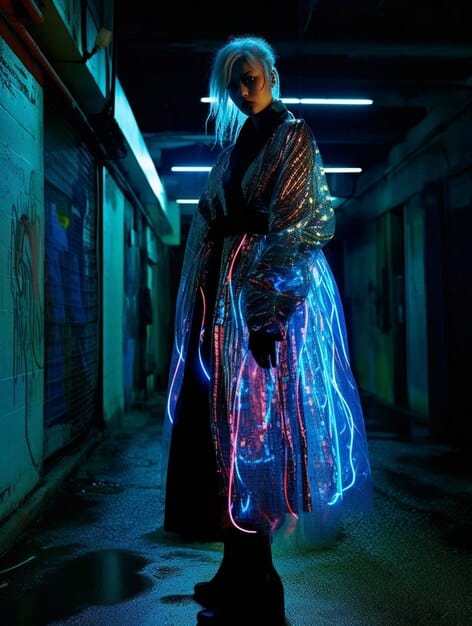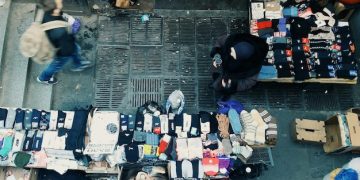Underground Fashion & Tech: Industry-Shaping Innovation

Underground fashion is rapidly evolving through technological advancements, from sustainable materials and digital design to immersive experiences and blockchain, fundamentally reshaping its creative processes, production, and distribution channels.
In the dynamic realm of fashion, the intersection of creativity and cutting-edge developments is nowhere more pronounced than in the domain of Underground Fashion and Technology: How Innovation is Shaping the Industry. This convergence is not merely a trend but a transformative force, enabling unprecedented design possibilities, sustainable practices, and direct engagement with niche audiences.
The Digital Renaissance of Underground Fashion
The digital era has ushered in a profound transformation across all industries, and underground fashion is no exception. More than just a tool, technology has become an intrinsic part of the creative process, production, and distribution within this niche yet influential sector. This shift empowers independent designers and labels to innovate beyond traditional boundaries.
Virtual Design and Prototyping
The adoption of digital design software and 3D modeling has revolutionized how underground designers conceptualize new pieces. Tools like CLO3D and Marvelous Designer allow for the creation of intricate garments in a virtual space, reducing material waste and accelerating the design cycle. This virtual prototyping is not just about efficiency; it opens avenues for highly experimental and complex designs that might be cost-prohibitive in physical form.
- Reduced Waste: Eliminating the need for multiple physical samples.
- Faster Iteration: Quick adjustments and redesigns in real-time.
- Complex Geometries: Experimenting with shapes and structures previously impossible.
Augmented Reality (AR) and Virtual Reality (VR) Experiences
Beyond design, AR and VR are creating immersive experiences for consumers. Pop-up shops might feature AR mirrors allowing customers to virtually “try on” garments without physical samples, while VR fashion shows transport audiences into surreal, digital environments. These technologies offer a unique way for underground brands to present their collections, bypassing the limitations of traditional retail and catwalks. This creates a more interactive and memorable brand experience, appealing to a tech-savvy audience. Virtual showrooms provide a global reach, democratizing access to exclusive collections.
The early adoption of these immersive technologies allows underground designers to cultivate a distinct brand identity that resonates with a tech-forward demographic. It fosters a sense of exclusivity and innovation, crucial elements for attracting and retaining followers in a competitive landscape. The ability to push creative boundaries through virtual realms is an exciting frontier.
The digital renaissance empowers underground fashion by providing tools for creativity, efficiency, and unparalleled consumer engagement. It reshapes how garments are conceived, presented, and experienced, fostering a more sustainable and accessible future for independent design.
Sustainable Innovation: Tech as an Eco-Conscious Ally
Sustainability has moved from a niche concern to a central tenet for many underground fashion practitioners, and technology is proving to be an indispensable ally in this crucial shift. From material science to production methods, technological advancements are enabling a more environmentally responsible approach to design and manufacturing. This represents a significant step towards mitigating fashion’s considerable environmental footprint.
Advanced Materials and Bio-Fabrics
Innovations in material science are introducing a new generation of sustainable textiles. Technologies facilitate the creation of bio-based fabrics derived from unlikely sources like mushroom mycelium, algae, or even food waste. These materials often offer properties comparable to, or even superior to, traditional textiles, such as enhanced durability, biodegradability, or unique textures.
- Mushroom Leather: Mylo™ and other mycelium-based leathers offer a cruelty-free, biodegradable alternative to animal leather.
- Algae-Based Dyes: Reducing reliance on synthetic and often toxic dyes.
- Recycled Synthetics: Advanced recycling processes transform ocean plastic or textile waste into high-quality new fabrics.
These developments are not just about environmental impact; they open new aesthetic and functional possibilities for designers seeking innovative textures and forms. The commitment to ethical sourcing and production is a defining characteristic of many underground brands.
On-Demand Production and Customization
The traditional fashion industry often relies on mass production, leading to significant overstock and waste. Technology, particularly digital manufacturing, offers a viable alternative through on-demand production. This model allows garments to be produced only when an order is placed, drastically reducing unnecessary inventory and material consumption.
Customization, enabled by digital body scanning and parametric design, further enhances sustainability by ensuring a perfect fit and reducing returns. This bespoke approach caters to individual preferences while minimizing waste from ill-fitting or unwanted items. It cultivates a slower, more thoughtful consumption cycle, contrasting sharply with fast fashion.
By embracing on-demand production, underground brands can maintain their agility and responsiveness to consumer trends without compromising their environmental values. This also allows for greater creative freedom, as designers are not constrained by minimum order quantities typical of traditional manufacturing.
Technology’s role in advancing sustainability within underground fashion is multi-faceted, addressing material innovation, production efficiency, and consumer engagement. It enables designers to create with a conscience, fostering a fashion ecosystem that is both innovative and environmentally responsible. It’s about crafting a future where style and stewardship go hand-in-hand.
Blockchain and NFTs: Revolutionizing Authenticity and Ownership
The burgeoning fields of blockchain technology and Non-Fungible Tokens (NFTs) are introducing unprecedented levels of transparency, authenticity, and innovative ownership models into the fashion industry, with underground designers being particularly keen to explore their disruptive potential. These technologies address long-standing issues like counterfeiting and opaque supply chains, providing new avenues for creative expression and brand-consumer relationships.

Ensuring Authenticity and Traceability
For underground brands, reputation and exclusivity are paramount. Blockchain provides an immutable, transparent ledger that can record every step of a garment’s journey, from raw material sourcing to manufacturing and sales. This end-to-end traceability combats counterfeiting, a persistent threat to independent designers, and verifies the ethical origins of materials and labor. Consumers can scan a QR code on a garment to access its entire provenance history, building trust and safeguarding the brand’s integrity.
- Supply Chain Transparency: Tracking materials and production processes.
- Anti-Counterfeiting: Verifying genuine products with unique digital fingerprints.
- Ethical Sourcing Assurance: Confirming fair labor and sustainable practices.
This level of transparency is particularly appealing to the discerning clientele of underground fashion, who often prioritize ethical production and unique pieces. It empowers consumers to make informed choices, aligning their purchases with their values.
Digital Ownership and Wearable NFTs
NFTs represent a paradigm shift in how we perceive ownership, extending it into the digital realm. In underground fashion, NFTs can represent unique digital garments that exist solely in virtual spaces, such as metaverse platforms or gaming environments. These “wearable NFTs” allow consumers to express their style in their digital lives, bridging the gap between physical and virtual identities.
Furthermore, NFTs are being used to create exclusive access tokens, granting holders unique experiences like early access to physical collections, private fashion shows, or direct interaction with designers. This fosters a highly engaged and loyal community, turning customers into active participants in the brand’s narrative. The concept of digital scarcity and verifiable ownership makes these virtual assets highly valuable within certain communities.
Blockchain and NFTs are more than just technological tools; they are foundational elements for a new fashion economy. They empower underground designers to protect their intellectual property, engage with their audience in novel ways, and build a more transparent and authentic industry. This digital frontier promises exciting possibilities for the future of fashion.
AI and Data Analytics: Personalization and Predictive Trends
The infusion of Artificial Intelligence (AI) and sophisticated data analytics into underground fashion is transforming how designers understand their audience, predict trends, and personalize offerings. Far from replacing human creativity, these technologies serve as powerful augmenters, providing insights that enable more informed design decisions and foster deeper connections with consumers.
Predictive Analytics for Trend Forecasting
AI algorithms can analyze vast datasets, including social media trends, sales data, and even street style photography, to identify emerging aesthetic patterns and predict future fashion directions. For underground designers, who often set rather than follow trends, this doesn’t mean conforming to mainstream tastes, but rather understanding evolving subcultures and niche interests with greater precision.
- Pattern Recognition: Identifying subtle shifts in consumer preferences.
- Sentiment Analysis: Gauging public opinion on colors, silhouettes, and themes.
- Micro-Trend Identification: Spotting nascent trends within specific subcultures.
This proactive approach allows designers to create collections that resonate deeply with their target audience, reducing the risk of producing unwanted inventory and enhancing efficiency. It also provides a competitive edge in a rapidly changing market.
Hyper-Personalization and Customization
AI can analyze individual consumer data – purchase history, browsing behavior, style preferences – to offer highly personalized recommendations and customization options. For underground fashion, this moves beyond generic suggestions to curating bespoke experiences. Imagine an AI suggesting fabric choices or design modifications based on your unique aesthetic profile, or even generating unique garment designs based on your input.
This level of personalization strengthens the bond between the brand and the individual, making the customer feel understood and valued. It also supports the ethos of uniqueness and individuality often celebrated in underground fashion. From tailored marketing campaigns to individually crafted items, AI enables a new era of consumer-centric design.
AI and data analytics, therefore, are not about automating creativity but about sharpening it. They provide the intelligence needed to navigate the complex landscape of consumer preferences and emerging trends, enabling underground fashion brands to deliver highly relevant and personalized experiences that truly capture their audience’s imagination.
Wearable Technology and Smart Garments
The convergence of fashion and electronics has given rise to wearable technology and smart garments, opening up entirely new dimensions for design and functionality. For underground fashion, this fusion is especially compelling, as it allows designers to push boundaries beyond aesthetics, embedding utility, interactivity, and unique performance capabilities directly into clothing. This represents a frontier where garments become more than just attire but interactive extensions of the wearer.
Beyond Aesthetic: Functional Fashion
Smart garments integrate sensors, microcontrollers, and communication technologies directly into the fabric or design, offering myriad functional applications. This can range from athletic wear that monitors vital signs and performance, to everyday clothing that adapts to environmental conditions. For underground designers, this means creating pieces that are not only visually striking but also offer tangible benefits or enhanced experiences.
- Health Monitoring: Garments that track heart rate, respiration, or posture.
- Environmental Responsiveness: Fabrics that change color, temperature, or texture based on light or heat.
- Interactive Elements: Clothing with integrated LEDs that react to sound or movement.
These innovations elevate the utility of clothing, making it a more integral part of people’s lives and enabling a new form of personal expression through functional design. The blend of form and function creates a compelling narrative for consumers.
Haptic Feedback and Sensory Experiences
Beyond purely practical functions, wearable technology can create novel sensory experiences. Haptic feedback, for instance, can be integrated into garments to provide tactile sensations, potentially for immersive gaming, communication, or even therapeutic purposes. Imagine a jacket that subtly vibrates to guide you through a city, or a shirt that provides calming pressure in stressful situations.
Sound integration, flexible displays embedded in fabric, and even subtle scent dispersal mechanisms are all within the realm of possibility. These advancements enable designers to engage multiple senses, crafting garments that offer a richer, more multi-dimensional interaction than ever before. This also opens up avenues for new performance art and interactive installations.
Wearable technology is transforming garments into intelligent interfaces that augment human capabilities and sensory perceptions. For underground fashion, this means an exciting opportunity to explore narrative, utility, and interaction in ways previously confined to science fiction, ultimately redefining what clothing can be and do.
The Social and Economic Impact of Tech on Underground Fashion
The pervasive influence of technology on underground fashion extends far beyond design and production, significantly altering its social dynamics and economic landscape. It has democratized access, fostered global communities, and reshaped traditional business models, offering both challenges and unprecedented opportunities for independent designers and niche brands.
Democratizing Access and Global Reach
Historically, underground fashion operated within localized scenes, limited by physical presence and word-of-mouth. Technology, particularly the internet and social media, has dismantled these barriers. Designers can now showcase their work to a global audience, directly connecting with like-minded individuals and bypassing traditional gatekeepers such as established fashion houses or exclusive boutiques.
- E-commerce Platforms: Direct-to-consumer sales, enabling wider reach.
- Social Media Engagement: Building community and brand identity across borders.
- Online Collaborations: Facilitating partnerships between designers and artists globally.
This democratization fosters greater diversity and inclusivity within the fashion ecosystem, allowing unique voices and aesthetics to thrive independently. It creates a level playing field for emerging talent.
New Business Models and Direct-to-Consumer (DTC)
Technology has enabled the widespread adoption of direct-to-consumer (DTC) models, eliminating the need for intermediaries and allowing brands greater control over their narrative, pricing, and customer relationships. For underground fashion, this means higher profit margins and the ability to maintain closer ties with their dedicated fanbase.
Crowdfunding platforms, subscription boxes, and limited-edition “drops” are other tech-enabled business models that resonate particularly well with the exclusivity often associated with underground fashion. These models foster anticipation and loyalty, allowing designers to gauge demand before production and build sustainable operations. The immediate feedback loop provided by online channels allows for rapid adaptation to consumer preferences.
While technology presents competition through increased market saturation, its overall impact on underground fashion is largely empowering. It has opened doors for creative expression, facilitated global connections, and allowed independent designers to build viable, sustainable businesses on their own terms, truly reshaping the industry from the ground up.
| Key Aspect | Brief Description |
|---|---|
| 🎨 Digital Design | 3D modeling reduces waste and speeds up prototyping, enabling complex, experimental designs. |
| ♻️ Sustainable Tech | Bio-fabrics and on-demand production minimize environmental impact & waste. |
| 🔗 Blockchain & NFTs | Ensures authenticity, traceability, and introduces new digital ownership models. |
| 💡 AI & Wearables | AI personalizes trends; wearables combine fashion with functional tech and sensory experiences. |
Frequently Asked Questions About Underground Fashion and Technology
▼
3D printing revolutionizes underground fashion by enabling designers to create complex, unconventional geometries and bespoke accessories that are challenging to produce with traditional methods. It supports on-demand production, reducing waste, and allows for rapid prototyping, fostering innovation and exclusivity in designs. This technology particularly benefits smaller, independent labels by lowering entry barriers for unique creations.
▼
While AI can generate novel design concepts and patterns based on learned historical and trend data, human creativity remains essential in underground fashion. AI acts as a powerful tool for inspiration and efficiency, suggesting new silhouettes or textile patterns. The unique cultural context, rebellious spirit, and personal narrative intrinsic to underground fashion require human artistic direction to truly resonate with its audience.
▼
Social media platforms are pivotal for technological advancements by serving as direct communication channels for underground fashion brands. They facilitate immediate feedback on new tech-enabled designs, enable viral marketing of innovative products like wearable tech, and serve as virtual runways for AR/VR fashion presentations. These platforms democratize access for designers and foster global communities around niche aesthetics and experimental technologies.
▼
NFTs offer underground fashion designers unprecedented benefits by enabling verifiable digital ownership and authenticity for their creations, both physical and virtual. They combat counterfeiting, provide a new revenue stream through digital collectibles, and can grant exclusive access to brand experiences or limited-edition drops. NFTs also foster direct engagement with loyal communities, empowering designers to retain control and value within their unique artistic vision.
▼
Yes, sustainable technology is becoming increasingly accessible to small underground fashion brands. Innovations like open-source software for digital design, smaller-scale 3D printers, and collaborations with sustainable material manufacturers make eco-friendly practices viable. The focus on local, on-demand production, often enabled by technology, also aligns well with the agile and community-centric nature of underground brands, reducing the need for large-scale investments.
Conclusion
The profound integration of technology into underground fashion marks a definitive epoch, moving beyond mere innovation to fundamentally reshape the industry’s terrain. From the genesis of virtual design and the ethical embrace of sustainable materials to the revolutionary transparency offered by blockchain and the hyper-personalization driven by AI, technology serves as both a catalyst and an enabler. It democratizes access, empowers independent creators, and redefines the very essence of what fashion can achieve. As this dynamic interplay continues to evolve, underground fashion remains at the vanguard, harnessing technological prowess to push creative boundaries, champion ethical practices, and forge a future where innovation and individuality converge seamlessly.





